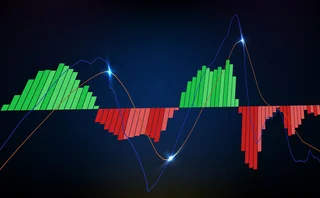
How a machine learning model closed a hidden FX arbitrage gap
MUFG Securities quant uses variational inference to control the mid volatility of options
In 2022, Yoshihiro Tawada, head of FX-flow quant modelling at MUFG Securities EMEA, noticed an anomaly in the market for Turkish lira/yen options. During periods of market turbulence, the mid volatility of options – which theoretically should lie between the bid and ask levels – breached those boundaries, contradicting the assumptions behind models used to price exotics and leaving them wide open to arbitrage strategies.
The breaches are the result of a peculiar convention in the FX options market, whereby prices are quotes in terms of the volatilities for given deltas and expiry dates. Pricing screens typically display the volatilities for at-the-money (ATM) options, risk reversals and butterfly structures. These values must be converted to obtain the implied volatilities for the bid and ask levels from which strike rates are derived. When the markets move violently, that process can produce anomalous results and the order of strike may even reverse in extreme circumstances.
“Since the mid volatility is just a mid-point of bid and ask volatilities, even though bid or ask quotes themselves are arbitrage free and give correct order-of-strike rates, there is no guarantee that the mid volatilities do so,” says Tawada.
“Under market turmoil, typically the volatility becomes high and the bid and ask spread becomes larger as well. As a result, the mid volatilities become more likely to cause arbitrage,” he explains. “When the mid ATM volatility is very high it can even happen that the strike rate of premium-adjusted delta-neutral ATM becomes lower than the strike rate of a put at -0.25 delta.”
Standard modelling usually starts from the premise that the data is consistent, but here the objective is to iron out those outlying data points and build a better-shaped volatility surface
A senior quant analyst at a large European bank
And this effect is not unique to lira/yen options. “As this is a matter of volatility level and smile shape, theoretically it can happen to any currency pairs,” says Tawada.
Arbitrageable mid volatilities can be a huge problem when pricing exotic instruments such as butterflies, which are composed of out-of-the money puts and calls. If the strike order is not consistent, some components of a butterfly would contradict the assumptions behind the structure, causing pricing models to malfunction.
“In general, evaluation models are based on risk-neutral pricing where no arbitrage and no transaction cost in hedging are assumed,” says Tawada. “It is necessary to feed one set of arbitrage-free market data into the model. Therefore, if one calibrates the model with volatilities that cause arbitrage, the model parameters would not be appropriately calibrated, and the model would not be able to reproduce the input market data.”
Tawada tackled this problem using variational inference, a machine learning technique for approximating probability distributions of latent variables. In this case, the latent variable – the mid volatility – is approximated from the observable bid and ask values by an optimisation process. The approach minimises the difference between the expected normal distribution of implied volatilities and the distribution that satisfies the no-arbitrage condition. As a result, the mid volatility derived from the bid and ask volatilities stays within the theoretical boundaries, ensuring that the implied volatility surface is arbitrage free.
While the mathematical and probabilistic proof of the validity of Tawada’s solution is complex, its application is relatively straightforward. “The algorithm itself is not complicated, because other than the arbitrage-free and strike-order consistency conditions, it results in just the minimisation of some quadratic functions,” says Tawada.
Front-office quants that have reviewed the paper agree. “It’s a sensible solution to a practical problem traders have to deal with when they see inconsistent data coming from the market,” says a senior quant analyst at a large European bank. “Standard modelling usually starts from the premise that the data is consistent, but here the objective is to iron out those outlying data points and build a better-shaped volatility surface.”
Tawada’s solution can also potentially be deployed in other areas beyond FX options trading where volatility spikes can challenge the no-arbitrage condition. To measure vega risk, for example, traders normally ‘bump’ volatilities and observe the resulting numerical difference. Bumped volatilities could in theory run into an arbitrage problem. “One way to mitigate this is to allow for the bumps in the conditions of arbitrage-free and strike-order consistency, and then run the algorithm,” says Tawada.
Another application could be smoothing the shocked market data of stressed scenarios. When using historical data to generate extreme scenarios, arbitrage and strike-order conditions can be violated, but that risk could be reduced by using the algorithm to control the boundaries of the stressed market.
Only users who have a paid subscription or are part of a corporate subscription are able to print or copy content.
To access these options, along with all other subscription benefits, please contact info@risk.net or view our subscription options here: http://subscriptions.risk.net/subscribe
You are currently unable to print this content. Please contact info@risk.net to find out more.
You are currently unable to copy this content. Please contact info@risk.net to find out more.
Copyright Infopro Digital Limited. All rights reserved.
You may share this content using our article tools. Printing this content is for the sole use of the Authorised User (named subscriber), as outlined in our terms and conditions - https://www.infopro-insight.com/terms-conditions/insight-subscriptions/
If you would like to purchase additional rights please email info@risk.net
Copyright Infopro Digital Limited. All rights reserved.
You may share this content using our article tools. Copying this content is for the sole use of the Authorised User (named subscriber), as outlined in our terms and conditions - https://www.infopro-insight.com/terms-conditions/insight-subscriptions/
If you would like to purchase additional rights please email info@risk.net
More on Views
Filling gaps in market data with optimal transport
Julius Baer quant proposes novel way to generate accurate prices for illiquid maturities
Georgios Skoufis on RFRs, convexity adjustments and Sabr
Bloomberg quant discusses his new approach for calculating convexity adjustments for RFR swaps
A dynamic margin model takes shape
New paper shows how creditworthiness and concentrations can be reflected into margin requirements
How HSBC got better at pricing share buy-backs
Monte Carlo approach generates faster, more reliable pricing for complex deals
Degree of influence 2023: Quants thrive on volatility
Climate, crypto and market impact also featured among the top research topics in 2023
How to account for banks’ contribution to CO2 emissions
Price adjustments will depend on individual counterparties’ carbon footprints
Exploiting causal biases in market impact models
Model calibration gains efficiency by including biased but adjusted trading data
Skew this: taking the computational burden off basket options
Dan Pirjol presents a snap formula for estimating implied volatility skew in an instant








